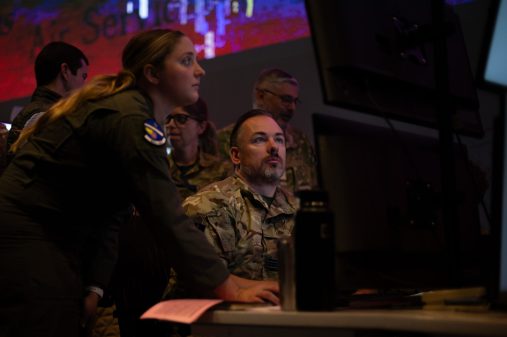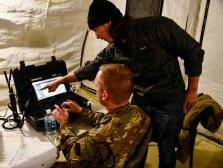Army turning attention to AI for decision dominance with Next-Gen Command and Control

The Army is pushing industry to develop capabilities that support “decision dominance” on the battlefield, utilizing artificial intelligence tools to better make sense of data.
The effort is part of the service’s sprawling Next Generation Command and Control (NGC2) initiative, one of its top modernization priorities to provide commanders and units a new approach to manage information, data, and command and control with agile and software-based architectures.
Army officials have said NGC2 is composed of a horizontal operational design that involves a technology stack that goes from a transport layer to an integration layer to a data layer to an application layer, which is where soldiers interact with it. That application layer is also where the Army has broken down the silos of individual warfighting functions — such as intelligence or fires — into applications that ride on the same integrated backbone.
A team of vendors led by Anduril was awarded a nearly $100 million contract last week to continue prototyping for NGC2 and scale it to a full division with 4th Infantry Division.
Despite the award, the Army is pressing on to continue offering industry opportunities to support the program. The Army is planning to continue releasing periodic so-called characteristics of need statements, which initially served as an acknowledgement of a complex problem space, officials said.
In doing so, the service doesn’t seek to prescribe requirements for industry, but rather provide them with a broad set of challenges they could then seek to develop creative solutions against.
The most recent update, which was just recently signed out, targets decision dominance.
“To me, decision dominance is reflective of a concept,” Joseph Welch, deputy to the commanding general at Army Futures Command, told reporters on the sidelines of a daylong conference hosted by AUSA on Tuesday. “The concept of an OODA loop or a killchain has been one that’s been well established for some time and obviously very consequential to the outcome of a military engagement.”
Officials have stated that one of the most important aspects for NGC2 is the data layer. To realize the stated vision for NGC2 — the ability for commanders to do “more, better, faster” — commanders need to make sense of their data quicker than the adversary.
“The biggest thing for us is the data layer and that’s where artificial intelligence and future capabilities like artificial intelligence come in. We have to understand the data and how we integrate data across a different platform. All of our forces need access to that same level of data. For artificial intelligence, for C2, decision dominance is the answer,” Col. (P) Mike Kaloostian, the incoming director of the C2 cross-functional team for Army Futures Command, told the conference. “Whoever is able to sift through the amount of data that’s going to be available on the battlefield of tomorrow, to sort through that and use that information effectively to make decisions that force is going to win war. There’s no doubt about it … AI-enabled decision dominance is where we need to come and what the future is.”
The updated characteristics of need with the new decision dominance focus provides industry with a baseline to work off of.
Officials noted that data has to be in the right place and AI is ineffective if the location of data is unknown or isn’t in a place where it can be analyzed.
As the Army continues to work with industry partners — either working on the prototype or others still vying for future NGC2 efforts — to establish a data integration layer and scale it, there must be a destination for all the data to go.
Industry can help the Army figure out what that data plane looks like and how the service is bringing in data, ingesting it and sorting through it to make it relevant to commanders in real time. Areas the Army is interested in include using capabilities such as edge computing to process data and decisions faster than the adversary in the dirt.
Continuing characteristics of need for industry
When the initial characteristics of need concept was first announced, the plan was to update it every 90 days or so as the Army conducted exercises and experiments to keep industry abreast of the latest observations.
The plan, even after the prototyping contract, is to continue updating it; however, the cadence might shift.
Welch described periodic updates that will be based on lessons learned, which will likely come from home station events with 4th Infantry Division at Fort Carson.
“We’re focused now on our work with our awarded team. We’re focused on the work that we’ll have upcoming through the” commercial solutions offering, he said, describing an ongoing effort with the program office to evaluate additional vendor teams and capabilities with the vision of adding them on in the future. “We’re focused on 4ID in our first prototyping initiative right now and I think there’s a lot that’ll be coming from that.”
He said the Army needs to continue to convey where opportunities exist for industry, and the characteristics of need aims to lay things out broadly, including for the Army, to understand the scope of what it is looking for.
“We’re going to continue to describe what we know about the capability as we work into prototyping, what we think we have solved and where we still think there are challenges,” Welch said.
The prototyping effort will help the Army discover what the NGC2 architecture looks like.
“We were very resistant to providing an architecture up front for companies to bid on, not because we don’t understand the importance of it, but because we feel it’ll likely be emergent as we work through, continue on with the prototype, with whatever commercial software or sets of commercial software may underpin it. That’s something that will emerge as we continue to work the prototyping effort,” he added. “That may be a level of detail that may not be in the characteristic of need, but will certainly be, I think, very useful to industry in terms of understanding where the opportunities, the base of which to innovate upon, is going to get established.”
Welch noted that within the technology stack, he’s always envisioned sub-problem statements that components of teams can try to help solve.






